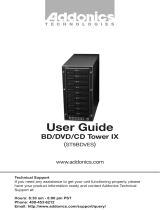
www.addonics.com Technical Support (M-F 8:30am - 6:00pm PST) Phone: 408-453-6212 Email: www.addonics.com/support/query/
The File Encrypt and Decrypt selections in the Replace the Originals
section work the same as dragging to the padlock icons.
Choosing File Encrypt in the Create a new Folder section will cause a new
folder to appear called AES_Encrypted, containing the encrypted version of
the files. Choosing File Decrypt in the Create a new Folder section will
cause a new folder to appear called AES_Decrypt, containing the
decrypted version of the files.
Performing encryption on a folder or drive will operate on all of the files in
that folder or drive. Note: the encryption and decryption functions do not
traverse through subfolders. Only the actual files in the selected folder or
drive will be encrypted. Files located in subfolders will not be affected.
Write Protect
Write protection only works with storage devices that are removable media,
such as USB Flash Drives or flash media in a standard reader. Write
protection will not work with Fixed disk media, such as USB hard drives or
SSD drives, the Addonics Pocket eSATA/USB DigiDrive, or eSATA hard
disks connected through adapters such as the Addonics USB 3.0 to
eSATAp Adapter or the Addonics USB 3.0 to eSATA Mini Adapter.
Write Protection works by blocking requests from the computer to write to
the media and does not protect the media from being written to if the media
is not connected to the CipherUSB device. It only works with the drive
connected through the CipherUSB.
There are two types of Write Protection available:
Write Protect Boot Record/MBR
Checking this box will cause the CipherUSB to refuse any write requests
from the computer to the first logical sector of the removable media. This
feature provides basic protection against malware attacks that attempt to
deploy payload at boot time or upon insertion of removable media.
Write Protect Entire Storage
Checking this box will cause the CipherUSB to refuse ALL write requests
from the computer to the removable media. This feature will protect all data
on the media from being erased or overwritten while in use with the
CipherUSB device.
















